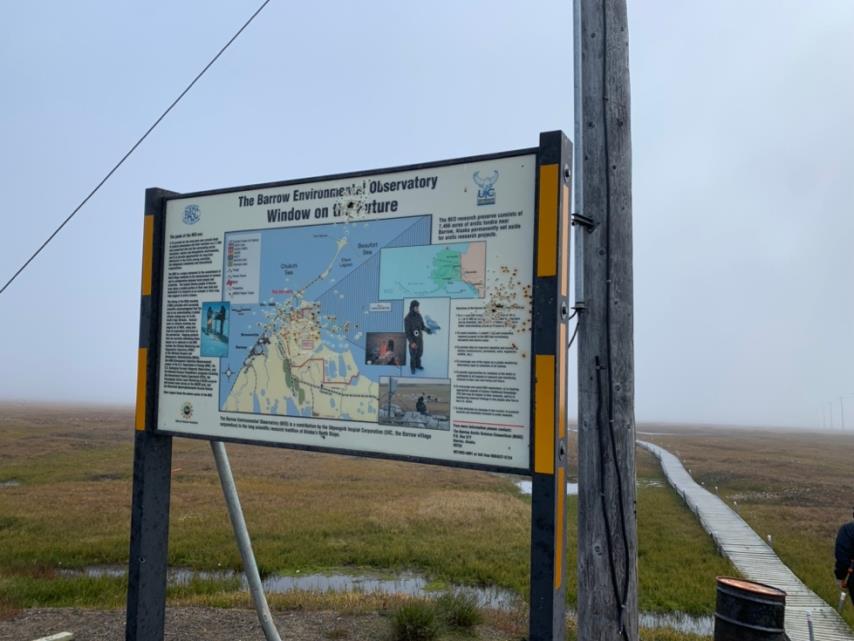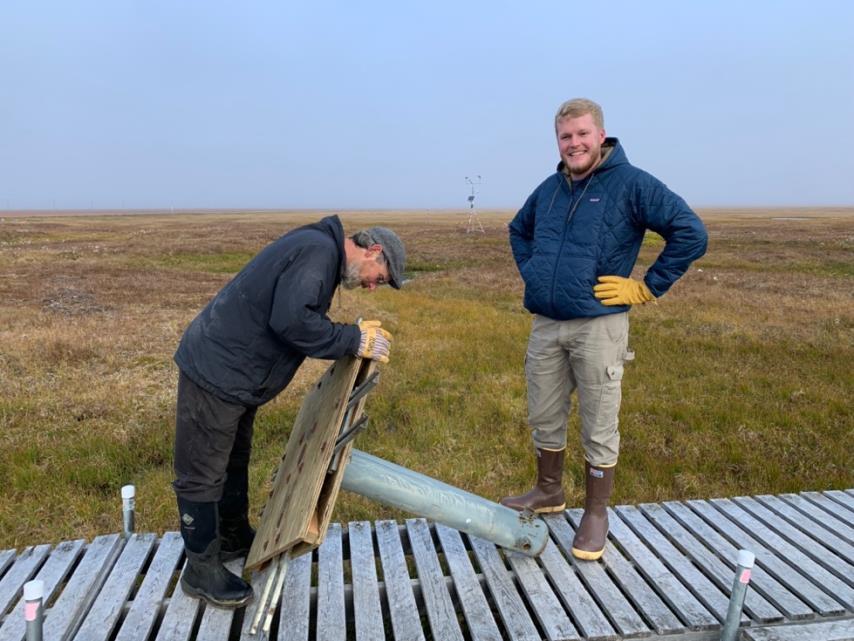E12 Is Hot! New ARM Site Collecting Data in Alaska
Published: 22 March 2023
Editor’s note: After the summer 2021 closure of the third ARM Mobile Facility (AMF3) at Oliktok Point, Alaska, the University of Alaska Fairbanks (UAF) precipitation mentor team of Matthew Sturm, Jennifer Delamere, Matthew Mockaitis, and Ken Irving suggested moving the snow instruments to another site in Alaska. Along with staff from Sandia National Laboratories, they worked on the installation of this new ARM North Slope of Alaska (NSA) site in Utqiaġvik (formerly Barrow). Data from the new site, called NSA E12, are now freely available through ARM Data Discovery. Sturm and Delamere wrote the following about the experience.

When the decision was made to close AMF3 at Oliktok Point (OLI), the question arose, “What to do with the snow instruments?” The UAF precipitation mentor snow group suggested that these be moved to a site about 5.5 kilometers (3.4 miles) south of the ARM NSA main site. With over 30 years of research experience in and around Utqiaġvik, the team had frequently noticed that when it was foggy and overcast at the NSA central facility (C1), it was clear and even sunny to the south. That southerly area is part of the Barrow Environmental Observatory, a large expanse of tundra that is dedicated to environmental research.
The decision was made to relocate the OLI snow instruments to the Barrow Environmental Observatory to learn more about these local coastal gradients. The Sandia group (Fred Helsel, Valerie Sparks, Justin LaPierre, Ben Bishop, and Todd Houchens) pulled the OLI instruments and shipped them to UAF. Then the permitting started for the new NSA E12 site.

Winter is a fierce opponent in Utqiaġvik. The snow of the 2021–2022 “winter” did not melt until June 21 (yes, on the solstice!). It usually snows in September, so not much time for site construction. The UAF and Sandia groups worked in June to identify the exact site of E12, then in parallel began to obtain the necessary instruments and deploy them. Sandia handled the power requirements, UAF the instrumentation, and Argonne National Lab (Pawel Lech) the communications link.
In late August, the main installation took place with the final instrumentation installed in November, just ahead of another Alaska coastal typhoon.
All the pieces seemed to come together surprisingly well, with far fewer hitches than we had any right to expect. Kudos to all involved.
The UAF mentor group worked with the ARM collections and ingest teams to get the data flowing into the ARM Data Center, and we are now engaging the QC team. As of March 21, 2023, the data are still at the a1 level, and data quality diagnostic plots are being made to identify possible issues. The mentor team will work on developing b1-level products for NSA C1 and E12, which will make the data more meaningful for users.
What comes next is the science. The UAF mentor group will undertake comparisons between NSA C1 and E12 data as the snow builds up. The expectation is we may see a noticeable precipitation gradient with increasing snowfall to the south. Enough weather monitoring instrumentation has been deployed that we should also get at least some indication of differences in cloudiness and wind. But a more comprehensive assessment will need to await the installation of other instruments like ceilometers at E12.
The site has room for instrument expansion, so ARM is considering what the next deployments will be.
Instrument List at NSA E12
(data products available in Data Discovery are listed in parentheses)
- 1 Laser Precipitation Monitor (LPM)
- 1 Heated Weighing Bucket Precipitation Gauge (WBGEONOR)
- 1 Camera for Routine Site Imaging (CAMPRECIP, CAMPRECIPMOVIE, CAMSPMFSRSMOVIE, CAMSRS, CAMSRSMOVIE)
- 1 Heated Sonic Anemometer (SONICWIND3D)
- 1 Meteorological Automatic Weather Station (MAWS)
- 2 Solid Precipitation Mass Flux Sensors (SPMF)
- 9 Heated Sonic Ranging Sensors (SRS) with 3 Air Temperature Sensors





Keep up with the Atmospheric Observer
Updates on ARM news, events, and opportunities delivered to your inbox
ARM User Profile
ARM welcomes users from all institutions and nations. A free ARM user account is needed to access ARM data.


















